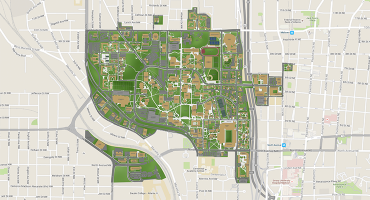TEXT
Natural disasters have a profound impact on human society. They caused 0.7 million deaths, influenced 1.7 billion people, and resulted in a total $1.4 trillion dollars in economic loss from 2005 to 2014. Understanding and predicting human mobility patterns plays a critical role in reducing the loss of life, injuries, and economic loss during such extreme events. This initiative examines the coupled system of human mobility and natural disasters, develops comprehensive data-collecting systems of human movements, and analyzes and predicts human mobility perturbation under the influences of various types of extreme events.
National Science Foundation #1760645
Hurricanes are a devastating natural disaster. It is urgent and time critical to develop, refine and test systems that can improve the ability of first responders and emergency management agencies to identify emergent crises before, during and after hurricanes. The research objective of this project is to develop a crisis detection, tracking and visualization system. Social media data collected before, during and after hurricanes will be used to develop and validate the system. The results of this research will improve the detection, tracking and visualization of emergent crises in hurricanes and other large scale natural disasters in the future by enabling the pinpointing of extreme crisis areas in the midst of an overall emerging crisis. This will be accomplished without prior definition of crisis topics to enable the detection of unexpected crises that are clustered in space and time, potentially leading to more lives saved. It will further provide first responder and emergency management agencies with a new understanding of the role spatially-referenced social media can play in increasing the effectiveness of disaster response efforts. The research findings and the detection, tracking and visualization system will be disseminated in presentations to emergency responders in coastal urban areas to demonstrate the system and encourage its implementation in future tropical cyclone seasons.
National Science Foundation #1142379
Existing human mobility data suffer several problems including lack of open access, low resolution, inadequate data samples, and questionable representativeness. This project—which extends from a study of network dynamics between occupants and buildings—designs a novel computational system to collect human communication and mobility data using Twitter, a large-scale social networking platform. This system is able to collect about 10 million geo-tagged tweets each day from the largest open access geo-social networking platforms. The system has been used to collect data since 2012. Initial analyses confirm it is a viable resource for studying perturbed human mobility. This project then examines collected high resolution “big data” from a large and representative population to study human mobility in extreme events.
TEXT
BioBuild, IGEP Virginia Tech
The BioBuild program is a new Interdisciplinary Graduate Education Program (IGEP) funded by the Graduate School at Virginia Tech. It was created to address pressing societal needs with interdisciplinary expertise informed by natural systems. The pedagogical objective of the BioBuild IGEP is to create and sustain a doctoral program at the confluence of the built environment and biology and foster competitive graduates with abilities to view grand challenges in the built and natural environments through an interdisciplinary lens. The objective of this BioBuild sub-project is to utilize bio-inspired mobility pattern understandings from animal populations to understand and predict human mobility under the influence of extreme events for: (1) perturbation – the changes of travel frequencies, locations, and trajectories in human movements, (2) resilience – correlations between human mobility during perturbation states and steady states, and (3) adaptability – the changes and recovery of travel patterns under the influence of tropical cyclones. This project aims to discover and simulation fundamental patterns of human mobility perturbation and develop predictive models to locate individuals missing in extreme events.
FUNDING
Georgia Department of Transportation
Amount: $99,998
Duration: 2019 – 2020
Title: Social Media-Informed Urban Crisis Detection
Georgia Smart Communities Challenge
Amount: $25,000
Duration: 2019 – 2020
Title: Smart Uptown Columbus
U.S. Dept. of Defense – Combating Terrorism Technology Support Office
Amount: $538,018
Duration: 2018 – 2020
Title: P2 Vision-Interactive Augmented Reality
National Science Foundation – Information and Intelligent Systems Program – Grant #1760645
Amount: $187,739
Duration: 2017 – 2019
Title: Discovering Crises Within Crises – Real-Time Detection, Tracking and Visualization of Emergent Crises in Hurricanes
National Science Foundation – Civil Infrastructure Systems Program – Grant #1142379
Amount: $400,000
Duration: 2011 – 2016
Title: Building Occupant Network Dynamics
Interdisciplinary Graduate Education Program (Virginia Tech)
Amount: $450,000
Duration: 2013 – 2017
Title: BioBuild – New PhD Program in Bio-inspired Building
COLLABORATORS
FACULTY
Ryan Pollyea
Assistant Professor, Virginia Tech
Ryan Wang
Assistant Professor, Northeastern University
Yan Wang
Assistant Professor, University of Florida
STUDENTS
Rachel Samuels
PhD Student, Virginia Tech


